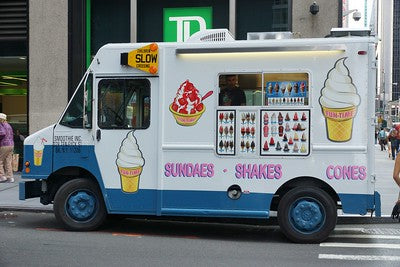

· By Chamoy City Limits
History of Ice Cream Trucks in America
The history of ice cream trucks in America dates back to the late 19th and early 20th centuries. The origin of this sweet and refreshing tradition is believed to be in the 1920s when ice cream vendors began selling their frozen treats from horse-drawn carts in various neighborhoods.

Here's a brief overview of the history of ice cream trucks in America:
-
Early Ice Cream Vendors: Prior to the invention of the ice cream truck, ice cream vendors sold their frozen treats from pushcarts on city streets. These vendors typically used insulated containers filled with ice and salt to keep the ice cream cold during transportation.
-
Motorized Ice Cream Trucks: As the popularity of ice cream grew, entrepreneurs saw an opportunity to expand their business by utilizing motorized vehicles to transport and sell ice cream. The first motorized ice cream trucks began appearing in the 1920s.
-
Good Humor Trucks: One of the most iconic names associated with ice cream trucks in America is "Good Humor." The Good Humor Corporation, founded by Harry Burt in Youngstown, Ohio, in 1920, became one of the pioneers in using refrigerated trucks to distribute ice cream throughout various neighborhoods.
-
Jingle Bells and Melodies: To attract children and announce their arrival, ice cream trucks began using catchy jingles and melodies, typically played through loudspeakers mounted on the roof of the truck. These jingles often became synonymous with the ice cream truck experience, and people could recognize the approaching truck by the sound of the music.
-
Post-World War II Boom: After World War II, ice cream trucks became even more prevalent as the economy improved, and suburban neighborhoods began to flourish. Ice cream trucks became a popular sight in residential areas, parks, and near schools during the summer months.
-
Diversification of Treats: Over time, ice cream trucks expanded their offerings to include a variety of frozen treats, such as ice cream bars, popsicles, and frozen novelties.
-
Regulations and Challenges: As the number of ice cream trucks increased, various cities and municipalities began implementing regulations to manage their presence. Some areas restricted ice cream truck operations due to noise concerns or safety issues, requiring them to follow specific routes or adhere to designated hours of operation.
-
Continued Popularity: Despite facing occasional challenges, ice cream trucks have remained popular throughout the years, providing a nostalgic and joyous experience for both children and adults.
Today, ice cream trucks are still a common sight in many American neighborhoods, continuing the tradition of bringing frozen delights to people during hot summer days.
